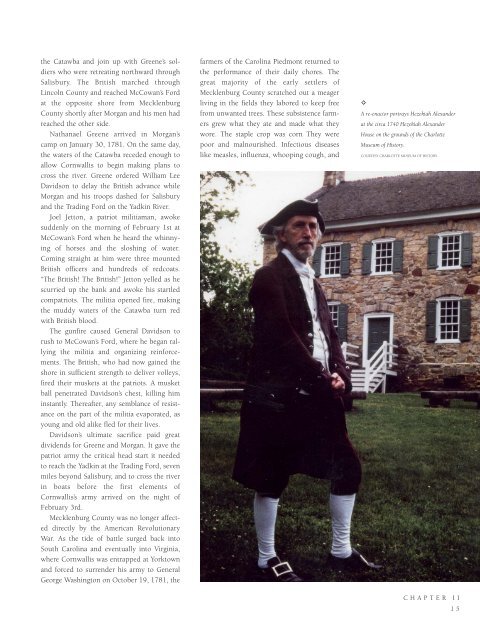Historic Charlotte
An illustrated history of the City of Charlotte and the Mecklenburg County area, paired with the histories of companies, families and organizations that make the region great.
An illustrated history of the City of Charlotte and the Mecklenburg County area, paired with the histories of companies, families and organizations that make the region great.
Create successful ePaper yourself
Turn your PDF publications into a flip-book with our unique Google optimized e-Paper software.
the Catawba and join up with Greene’s soldiers<br />
who were retreating northward through<br />
Salisbury. The British marched through<br />
Lincoln County and reached McCowan’s Ford<br />
at the opposite shore from Mecklenburg<br />
County shortly after Morgan and his men had<br />
reached the other side.<br />
Nathanael Greene arrived in Morgan’s<br />
camp on January 30, 1781. On the same day,<br />
the waters of the Catawba receded enough to<br />
allow Cornwallis to begin making plans to<br />
cross the river. Greene ordered William Lee<br />
Davidson to delay the British advance while<br />
Morgan and his troops dashed for Salisbury<br />
and the Trading Ford on the Yadkin River.<br />
Joel Jetton, a patriot militiaman, awoke<br />
suddenly on the morning of February 1st at<br />
McCowan’s Ford when he heard the whinnying<br />
of horses and the sloshing of water.<br />
Coming straight at him were three mounted<br />
British officers and hundreds of redcoats.<br />
“The British! The British!” Jetton yelled as he<br />
scurried up the bank and awoke his startled<br />
compatriots. The militia opened fire, making<br />
the muddy waters of the Catawba turn red<br />
with British blood.<br />
The gunfire caused General Davidson to<br />
rush to McCowan’s Ford, where he began rallying<br />
the militia and organizing reinforcements.<br />
The British, who had now gained the<br />
shore in sufficient strength to deliver volleys,<br />
fired their muskets at the patriots. A musket<br />
ball penetrated Davidson’s chest, killing him<br />
instantly. Thereafter, any semblance of resistance<br />
on the part of the militia evaporated, as<br />
young and old alike fled for their lives.<br />
Davidson’s ultimate sacrifice paid great<br />
dividends for Greene and Morgan. It gave the<br />
patriot army the critical head start it needed<br />
to reach the Yadkin at the Trading Ford, seven<br />
miles beyond Salisbury, and to cross the river<br />
in boats before the first elements of<br />
Cornwallis’s army arrived on the night of<br />
February 3rd.<br />
Mecklenburg County was no longer affected<br />
directly by the American Revolutionary<br />
War. As the tide of battle surged back into<br />
South Carolina and eventually into Virginia,<br />
where Cornwallis was entrapped at Yorktown<br />
and forced to surrender his army to General<br />
George Washington on October 19, 1781, the<br />
farmers of the Carolina Piedmont returned to<br />
the performance of their daily chores. The<br />
great majority of the early settlers of<br />
Mecklenburg County scratched out a meager<br />
living in the fields they labored to keep free<br />
from unwanted trees. These subsistence farmers<br />
grew what they ate and made what they<br />
wore. The staple crop was corn They were<br />
poor and malnourished. Infectious diseases<br />
like measles, influenza, whooping cough, and<br />
✧<br />
A re-enactor portrays Hezekiah Alexander<br />
at the circa 1740 Hezekiah Alexander<br />
House on the grounds of the <strong>Charlotte</strong><br />
Museum of History.<br />
COURTESY CHARLOTTE MUSEUM OF HISTORY.<br />
CHAPTER II<br />
15
















